In the CX spaces, we often talk a lot about customers and their feelings. Still, we don't really connect with what needs to happen for a customer to continue doing business with us. The same goes for the importance of customer retention.
At our recent webinar, Percy Rose, Head of Customer Success Strategy at Hewlett Packard Enterprise, explored the challenges of retaining customers in today's environment, emphasizing the value of strategic journey mapping.
Are you ready to learn more about strategic customer journey maps and delve into the process of creating one? Then brace yourself for not a theory but a case study. Only real experience, only CX hardcore.
Contents
The recording
Don't have time to read? Watch the event recording. After all, all the little details are there:
The significance of customer retention
Why is customer retention so vital, especially in customer experience and customer success?
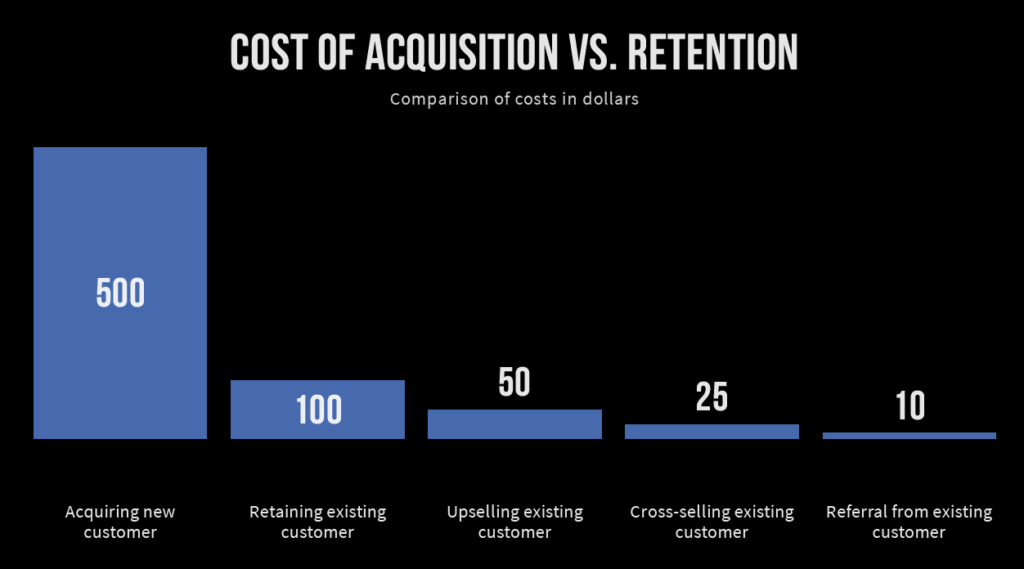
- Acquiring a customer is challenging, so it's essential to do your best to retain them.
- It's five times more expensive to acquire a new customer than to retain, upsell, or cross-sell to existing customers. It's far easier to sell to existing customers than new prospects, even if they seem genuinely interested in your product or service.
- Businesses can’t grow and develop without an existing customer base.
Very often, we don't have customer retention as a central point in developing our strategy. However, customer retention has become more challenging than ever before. Why?
In the past, a business may have had unique products, but today competitors are constantly on the watch, and there are a lot of similar products on the market. What distinguishes businesses now are their customers’ experience and customer success strategies.
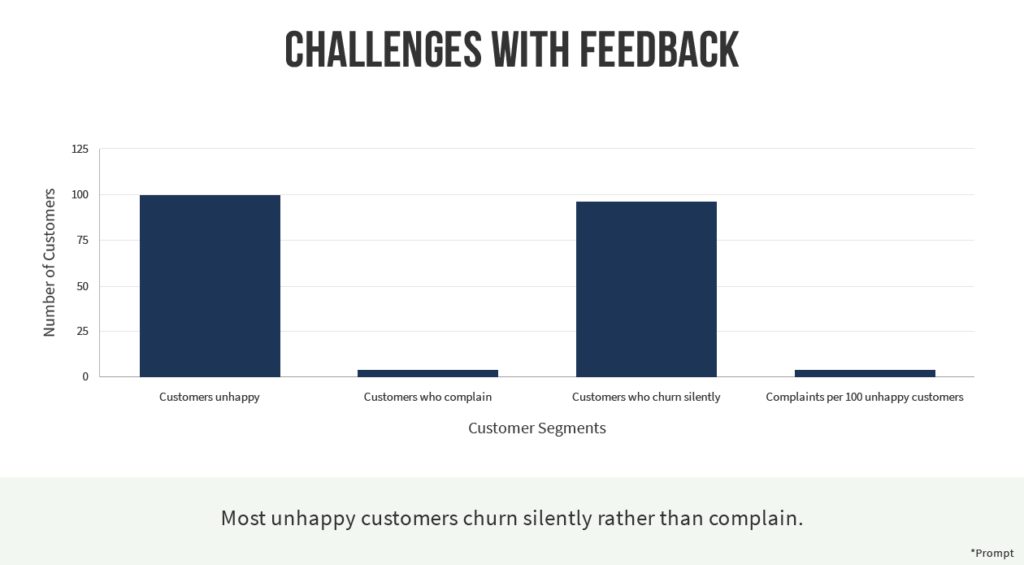
Another challenge is that unhappy or churned customers tend to be silent. Customers unhappy with you often do not provide feedback, making it difficult to gauge their sentiments and stay closely connected with your customer base. As a result, you cannot be completely sure that your customers are truly valuing their experience.
This is where strategic journey mapping comes into play. A strategic customer journey map serves as a vision. It's a high-level document that examines the factors contributing to a customer's ability to have a great experience with you. Ultimately, the experience plays a major role in their decision to continue doing business with you.
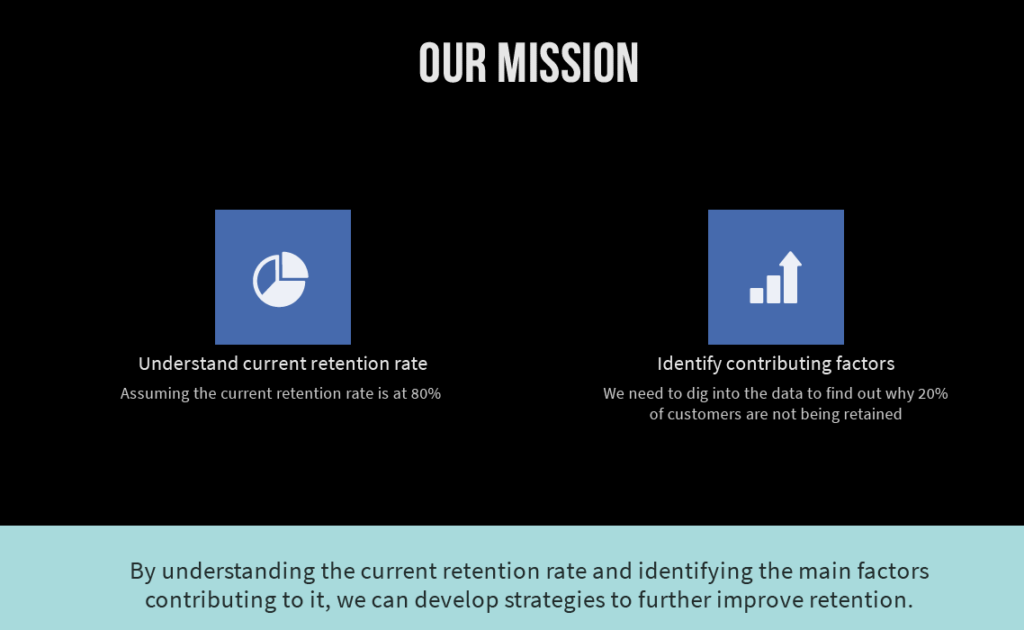
A real-life strategic journey map example
Now, let's look at the example of a strategic customer journey map HPE's team recently created in collaboration with a consulting agency, Heart of the Customer.
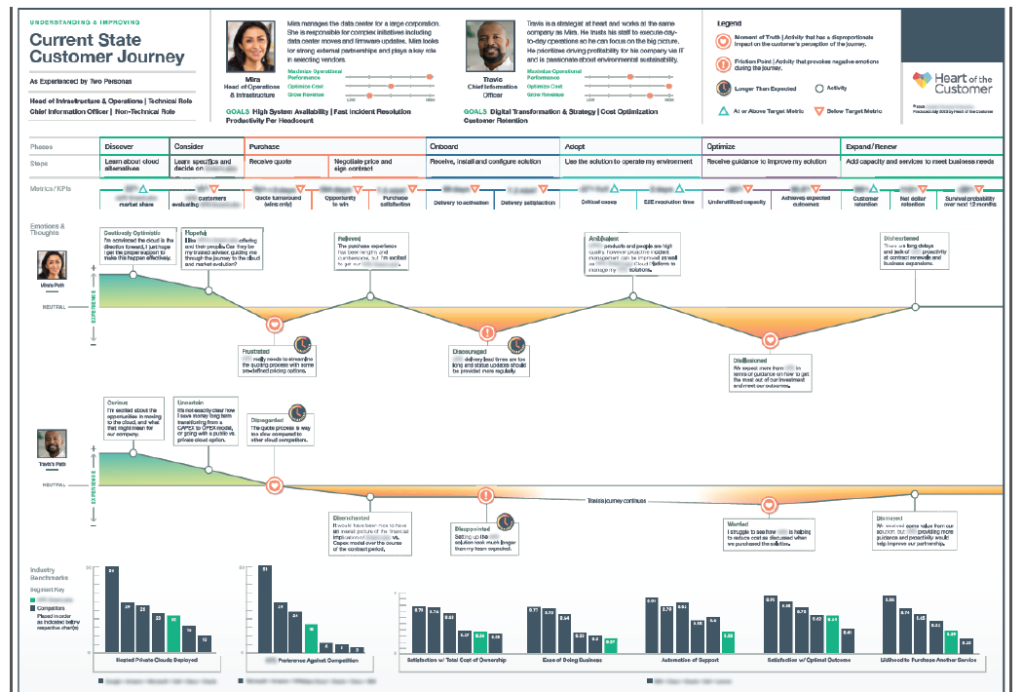
This strategic customer journey map has five components:
- Personas and outcomes;
- Journey phases;
- Key Performance Indicators (KPIs);
- Sentiment analysis;
- Competitive benchmarking.
There could be more components, but in this case, these were enough to provide a comprehensive view for assessing the retention rate and reasons for customer attrition.
Now, let's dive into the first component — personas and outcomes.
Personas
For their project, HPE created personas to represent their customer group and focus on what they value most and what truly matters to them.
“When building customer journeys, I avoid relying solely on surveys. While survey data has its place, I emphasize the importance of direct conversations with customers to achieve the level of detail and quality I seek.”
When working on the map above, Percy's team talked to 50 customers and balanced the results against the survey data to understand their personas and the outcomes they cared about most. That helped them get insight into customers’ decision-making and contributed to the ultimate goal — understanding what can help retain them.
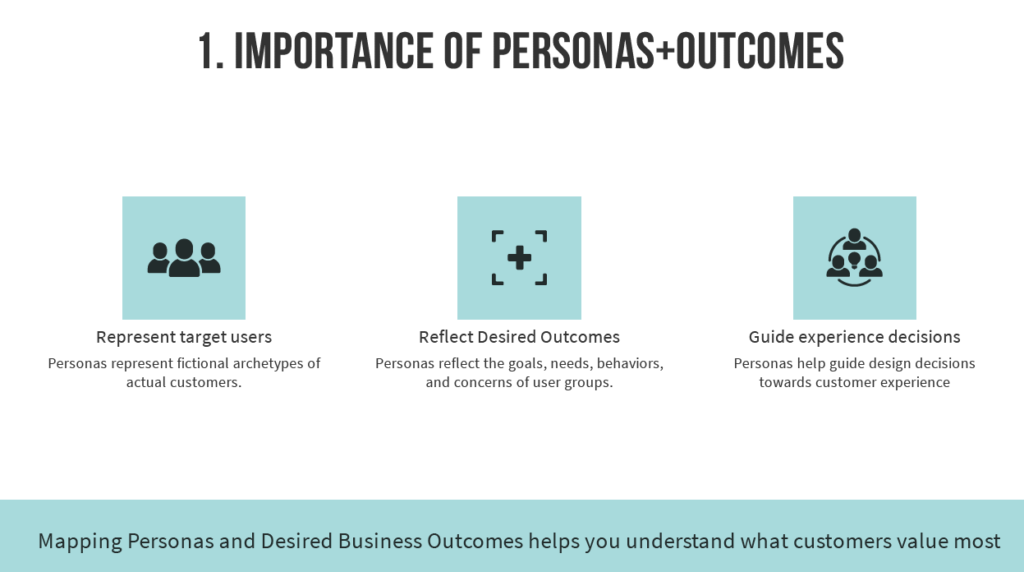
What was the final output? The multi-persona map above that showcases the journeys of two personas, Mira and Travis.
When creating personas, Percy’s team was focused on understanding their jobs, the related goals they aim to achieve, and the most important outcomes.
For example, Mira manages a large corporation's data center and is involved in various initiatives like firmware updates. The second persona, Travis, who is a CIO, prioritizes profitability.
In this B2B journey, Mira is measured on her ability as a data center manager to keep the data center running smoothly, while Travis is measured on his ability to use technology to make the business much more profitable.
Talking to customers helps you gain a clear understanding of their priorities. When conducting interviews with someone in a field you're knowledgeable about, an outcome-oriented approach can work effectively.
“I present a list of potential outcomes to interviewees and have them tell me which are the most important and why.”
The next step is to understand their priorities to determine how to measure success.
For example, Mira cares about maximizing operational performance, while Travis cares about optimizing costs and growing revenue.
Without comprehending why maximizing operational performance is valuable for Mira, we will never be able to establish a connection between Mira's preferences and whether she'll decide to continue purchasing from me.
Customer journey phases
With the personas in place, we are ready to identify the phases of the customer journey.
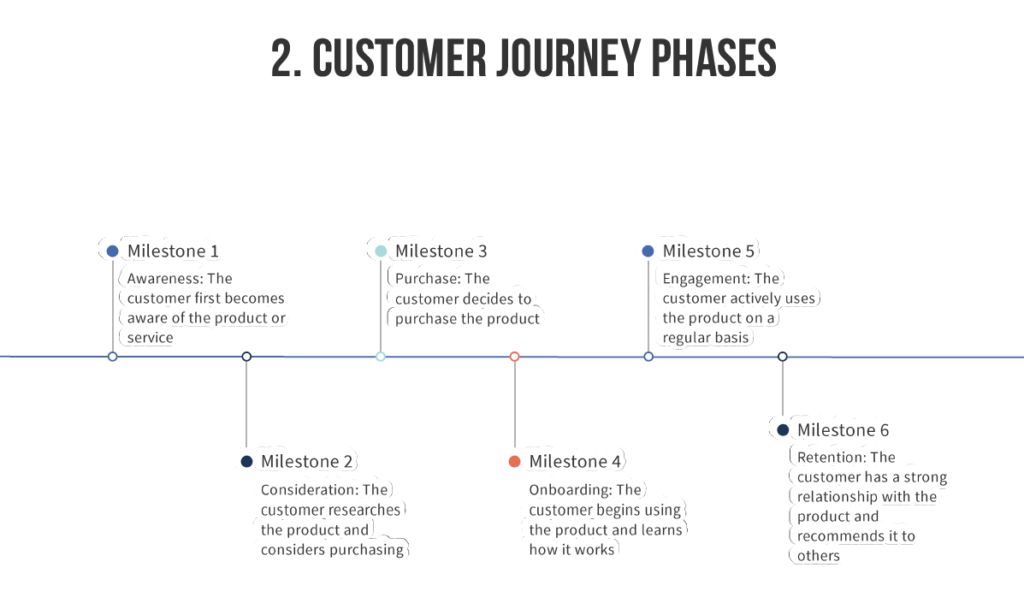
While the specific phases may vary depending on the business, they are likely to include Awareness, Consideration, Purchase, Onboarding, Engagement, and Retention.
The HPE’s map has the following phases:
- Discovery;
- Consider;
- Purchase;
- Onboard;
- Adopt;
- Optimize;
- Expand/Renew.
At the 'Discovery' phase, the customer expresses interest in making a new purchase. As they progress, they narrow down their options, considering our company along with others and evaluating various factors.
Eventually, they decide to purchase, move through an onboarding experience, and adopt our solution or products. In the following phase, they seek our assistance in optimizing their use.
Then the moment of truth of whether you can retain them arrives, and this should be a fundamental aspect of every strategic customer journey map. Ultimately, it all boils down to whether customers choose to renew, refresh, or expand with us. Have we done a good enough job throughout this journey to retain their loyalty?
KPIs
The third component, KPIs, adds depth to our strategic journey mapping exercise. It goes beyond qualitative information from interviews, like emotions. This aspect is especially crucial when communicating with executive leadership who talk numbers.
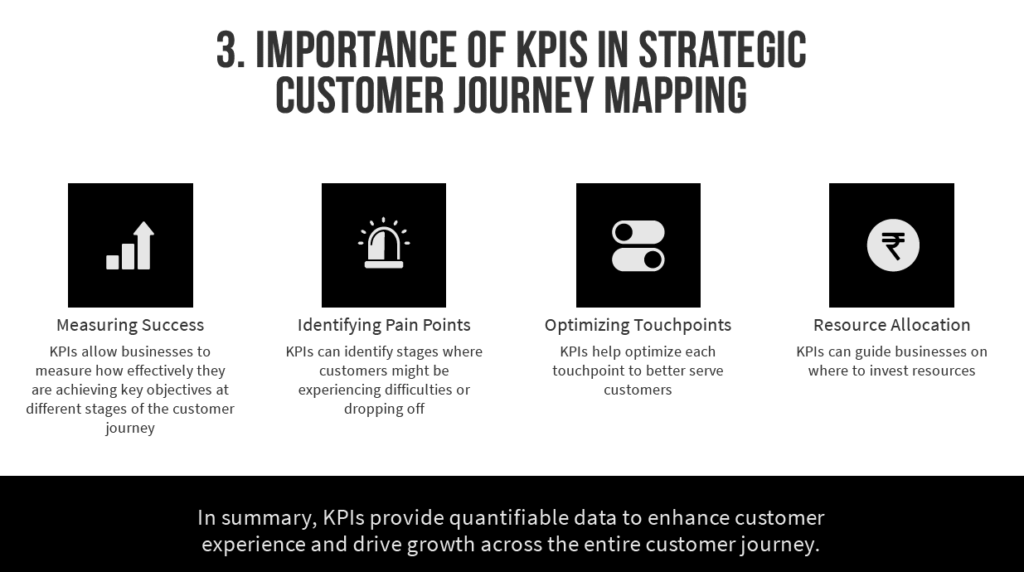
On this journey map, you can see the integrated KPIs beneath each phase. Please excuse the blurred lines — HPE must protect sensitive data.

These metrics helped them gain a deeper understanding of how different factors are impacting the customers.
For instance, during the onboarding phase, customers verbally expressed that it was a poor experience.
So, Percy’s team decided to examine the numbers, and they revealed that "the time to value," or what they referred to as "delivery to activation," was significantly longer than they had anticipated. This information helped validate the customers’ experience and gave them clear targets.
Additionally, they incorporated net dollar retention into their metrics. And, of course, they included the most critical metric — the customer retention rate.
Sentiment analysis
The fourth layer, sentiment analysis, helps gain a holistic understanding of customer emotions as they go through their journey.
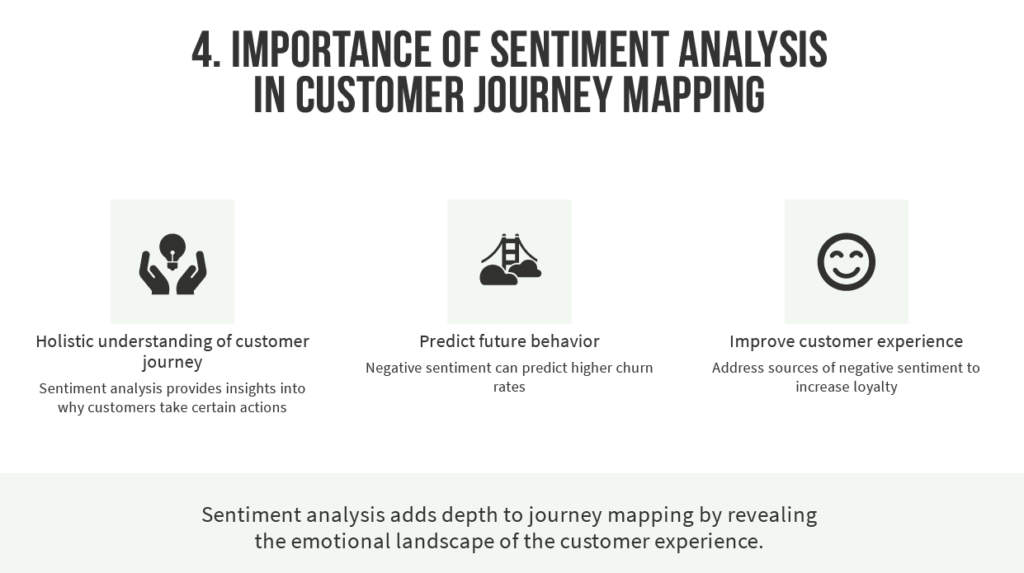
On our map, you can see how Mira and Travis's emotions evolve as they move through the phases. The heart means a phase has a major impact on the persona’s decision to leave or retain.
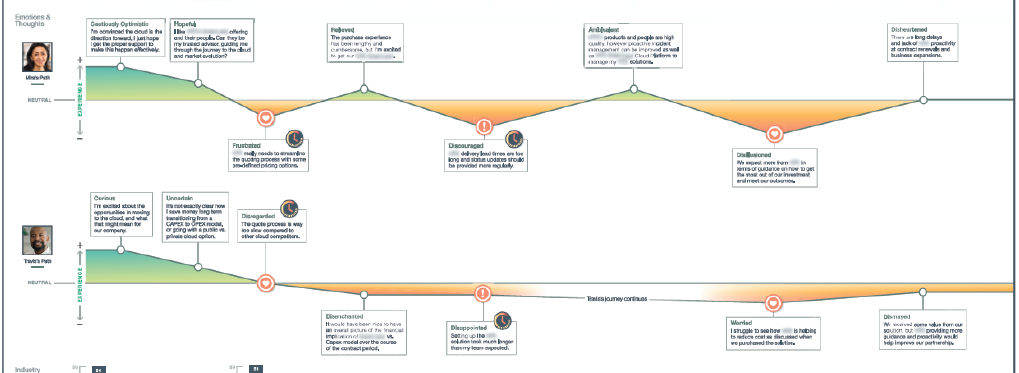
They both started positively, but the experiences got poor during the 'Purchase', 'Onboarding', and 'Optimize' phases.
HPE already knew the personas' priorities: Mira cared about maximizing operational performance, while Travis was primarily concerned with reducing costs and increasing revenue. They also knew that after starting to use HPE’s product or service, the personas sought guidance to achieve these particular outcomes. Therefore, the more effectively they could align with Travis and Mira's priorities, the more likely they would substantially impact those metrics.
That is how organizing all this information in a strategic map may help identify the actions needed to make a difference for your customers.
Competitive benchmarking
The final, fifth component of our customer journey map is competitive benchmarking.
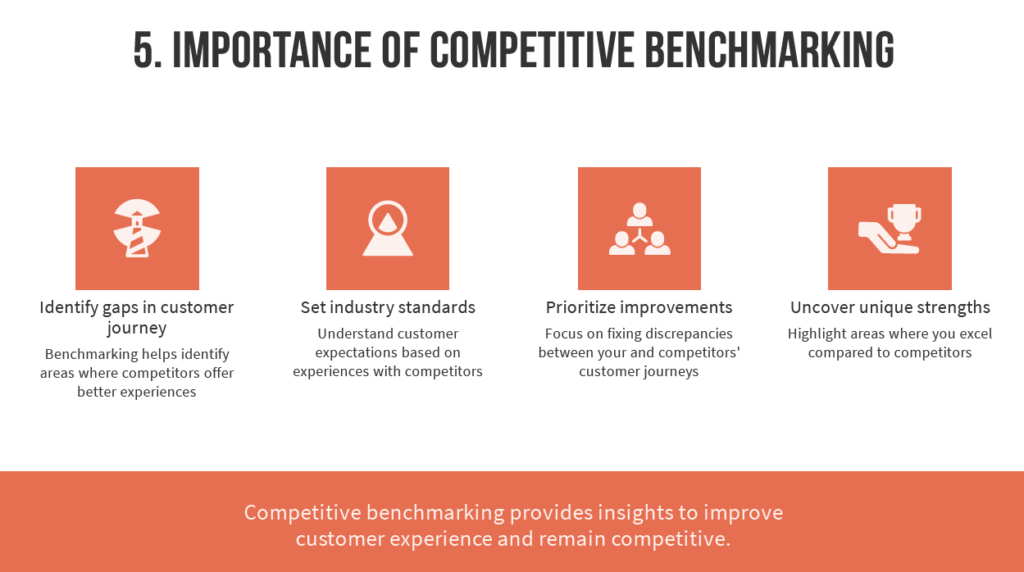
It's a powerful tool when communicating with a leadership team.
“Nothing will get them sitting on the edge of their seat more than when you're comparing against other companies.”
So, Percy’s team compared in-country HPE (represented by green) with other companies to show that they were falling short across the board. They found themselves either in the middle or lagging behind others compared to their top six competitors in this particular part of their business offering.

“When we measured what customers thought about us versus what they thought about some of our key competitors, unfortunately, we were behind.”
All five journey map components provided HPE with a comprehensive understanding of the current state of their customer retention rate. In simple terms, they had an "as-is" journey map that described the current situation.
The next step was to create a "desired state" journey map to outline targeted KPIs they wanted to achieve in two years. In virtual workshops, they gathered people from various departments, including marketing, sales, delivery, customer success, and customer experience.
“In our onboarding time frame, it was X in the current state, it should be Y in the future state.”
They had a target and could work with teams to put projects together, revise their processes and methodologies to deliver the desired state.
Percy’s team included the emotions for the "as-is" current state. The green represented the projected future state.
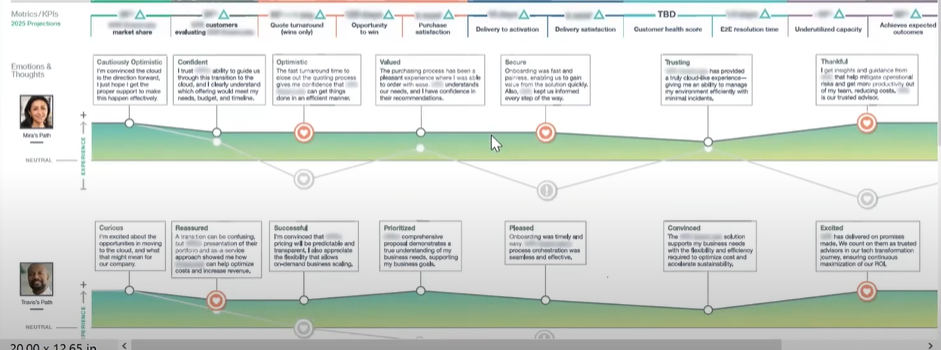
Percy’s team included the emotions for the "as-is" current state. The green represented the projected future state.
In the benchmarking section, they determined where they should rank compared to their competition based on the changes we were going to implement.

“We aimed for customers to perceive us as delivering value, security, and trustworthiness, resulting in gratitude.”
HPE established a clear starting point by understanding their customers and identifying the factors hindering their ability to achieve the desired retention rate. Then, they outlined areas that needed improvement. They recognized that purchasing, onboarding, and optimization were major contributors to their retention rate and developed strategies to address them differently moving forward. With as-is and to-be maps, HPE developed a clear vision to be at the core of its retention strategy.
Therefore, strategic journey mapping helped the organization identify the way forward; everyone now knows where to go.
Impact of strategic journey mapping on customer retention
Strategic journey mapping serves as the cornerstone of our retention strategy. It helps us understand our customers, what is important to retain them, and develop targeted solutions.
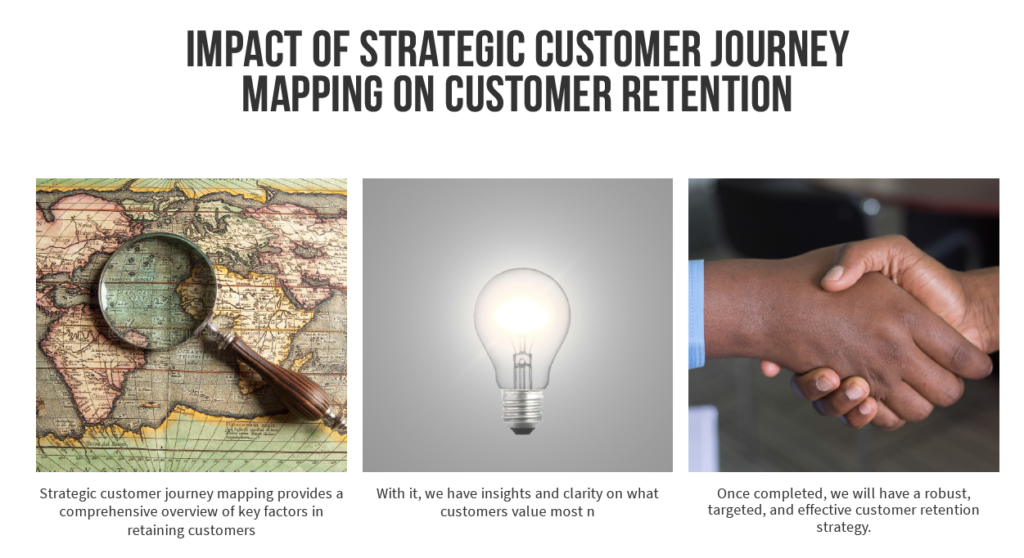
A well-executed strategic journey map provides critical insights into what customers value, helping develop a targeted retention strategy.
The Q&A
Here are some questions from the Q&A session with Percy (and not all of them are about strategic journey mapping). You can listen to others in the event recording 😉
How long did it take to create a journey map? How many iterations did you have?
Creating the journey map took about five months, mainly due to customer interviews, data analysis, and organization. The interview process duration can vary and depends on team size. After collecting data, the actual map production took around a month, with multiple iterations. The pre-map work, involving customer engagement and data analysis, was the most time-consuming part.
How did you get around to speaking to 50 customers? What strategy did you employ for that?
We involved account teams and customer success managers who already have relationships with customers. Initially, direct outreach for interviews yielded no responses. So, we turned to account and success managers, sometimes offering incentives to motivate them to identify interested customers.
Remember that maintaining independence during interviews is crucial. Customers tend to be more honest when their account or success managers are not present during the conversation. This helps gather unbiased feedback.
How do you narrow down the appropriate personas?
We narrow it down to who's actually buying and who's closest to the decision-maker as an influencer. In larger deals, the CIO is often the buyer, while the head of infrastructure or Mira heavily influences the CIO. In smaller deals, Mira might be the buyer if it fits within the budget. The focus is on who's signing the check in the end.
What did your persona creation process look like?
We began with customer research and initially consulted the marketing team, which provided a list of around 15 personas. Then we narrowed it down to the most crucial ones for our retention strategy. For example, if a persona, like a user among 15,000 people in an organization, wasn't influential, we didn't track it. We focused on personas' key success metrics, such as profitability for the CIO and operational performance for Mira, to build our list of outcomes.
How many client interviews determine statistical significance for you?
We typically conduct around 25 to 30 interviews, but interestingly, after about 15 interviews, we start seeing clear patterns and can almost predict customer responses.
Are all the KPIs and metrics linked to revenue, or are they linked to other points like satisfaction?
Yes, we strike a balance by using various metrics. For instance, in the onboarding phase, we focus on "time to value." If customers expect to derive value within 30 days, and it's taking 75 days on average, that's a significant pain point. While “time to value” isn't strictly a financial metric, it's linked to the overall customer experience and influences their decision to continue doing business with us. It can impact their perception when it's time to renew the contract.
At what point do you create a customer journey, especially when you don't have much data?
You can create your vision right from the beginning, even if you're a startup or a new company. This exercise helps you focus on what customers should experience and the outcomes you want to enable for them. It's easy to get caught up in loving your product, but customers care about the outcomes they can achieve, not just the product itself. By outlining your vision early on, you ensure that your product aligns with these desired outcomes, even if you have no customers at the start. It's a guiding light for your company's journey.
About the speaker
Percy Rose is the Head of Customer Success Strategy at Hewlett Packard Enterprise, where he is responsible for driving strategic improvements in their +$1 Billion hybrid cloud portfolio based on insights gained from the voice of the customer. Through outcome engineering and customer journey mapping, Percy helps HPE connect the dots between what the company offers, what customers value most, and the strategic transformation initiatives needed to bridge any gaps. He is an outside-in thinker who believes that delivering value for the customer as well as constantly improving the ease of doing business is at the core of increasing customer retention & expansion rates.
Percy is a passionate leader who is committed to enabling business outcomes for his customers through HPE products and services.
Prior to joining HPE, Percy worked at Accenture where he gained expertise leading complex global SAP systems integration programs for Fortune 500 clients. As a seasoned account leader, he has extensive experience working internationally with customers in England, Sweden, France, and Germany. Percy received his BA of Communications and Broadcast Journalism degree from the University of Notre Dame in 1997.





